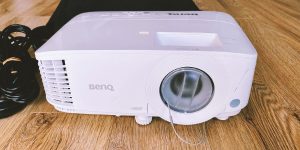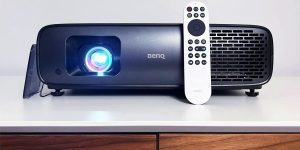Projectors provide a great way to take your favorite sports shows to a massive screen. With the right device, you will get an ultimate viewing experience with a feeling as if you are inside the game. But not all projectors are the same. Some are more fit for sports than others. So, what makes these devices so unique? That’s what we will look at in this review. You will also get a list of the best projectors for sports along with their detailed overview.
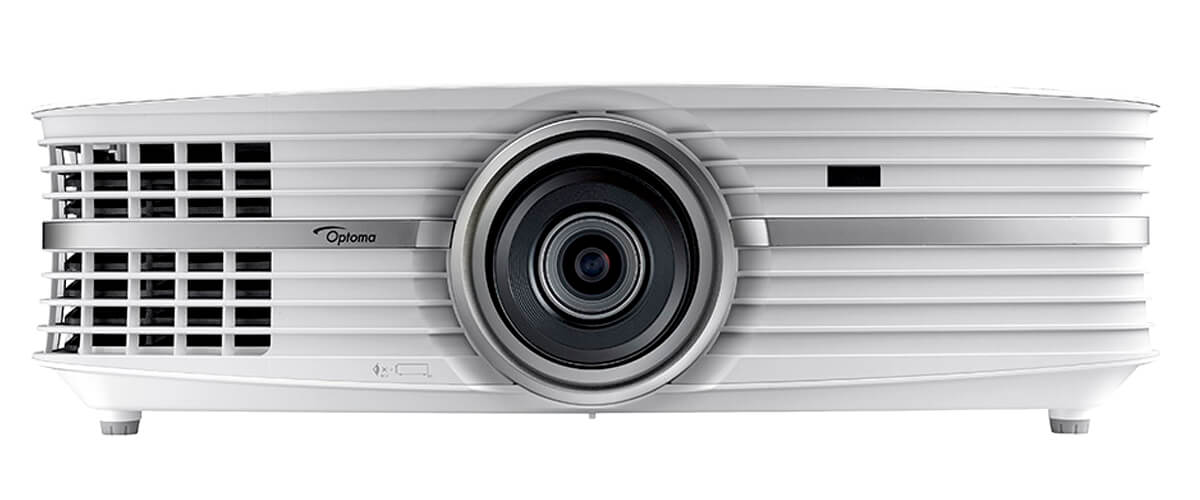
Projector for sports comparison table
| Name | Display technology | Resolution, px | Brightness, ANSI lumens | Contrast | Review |
|---|---|---|---|---|---|
| Optoma UHD60 best overall | DLP | 3840×2160 | 3000 | 1000000:1 | Review |
| ViewSonic PX748 4K for outdoor sports watching | DLP | 3840×2160 | 4000 | 12000:1 | Review |
| BenQ TK800M for sports bars | DLP | 3840×2160 | 3000 | 10000:1 | Review |
| Hisense PX1-PRO short throw | DLP | 3840×2160 | 916 | 1000000:1 | Review |
Things to сonsider in a sports projector
A projector can be a matter of a ‘make-it-or-break-it’ thing when it comes to elevating your sports viewing experience. With the myriad of options on the market, it may be hard to settle for the one that will project the highly-paced sports content without lags and with great attention to detail. So, let me shed light on what features to look for when you decide to opt for a projector for watching various sports content.
4K
Aside from 8K, which is just paving its way to the masses, 4K is the highest quality option widely accepted by both content makers and viewers. The ultra full-HD 3840 x 2160 resolution is capable of delivering the most satisfying sports-viewing experiences. As sports video content is usually centered around little details and fast-moving scenes, the projector with a 4K native resolution will decently handle it all.
Bright lamp
To enjoy the versatility of use, you may want to have a projector with high-lumen parameters. For instance, an outdoor projector should have at least 2,500 lumens (but the more, the better). It is also a preferred choice if you treat yourself to occasional sports game-watching in the middle of the day (and it means a certain degree of ambient light). Otherwise, you should think of ensuring a watching space in complete darkness to achieve a crisp image that doesn’t look washed out.
Keystone and corner adjustment
If only finding that perfect spot for your projector would have been that easy. No one would ever have to use the keystone correction and corner adjustment. Yet, the reality is that sometimes you can’t place the device right opposite the screen. Or adjust the optimal angle for an adequate projection. In these cases, you will need to use keystone and corner adjustments. Preferably, automated ones so you do not have to manually change the settings every time you move the projector.
Connectivity
All projectors have at least one HDMI port. It means that you can connect the A/V source without risking spoiling the reproduction quality. Also, you will probably want to connect the projector to speakers or the audio system. Make sure the product of your choice has enough ports to hook all the gadgets you plan to use along with it.
Having an option of a wireless connection will be a big advantage. You will not only avoid the hassle of handling all those nasty cables but will also connect devices like speakers without leaving your cozy couch.
Best projector for sports reviews
Optoma UHD60 – best overall

Sports fans can now finally enjoy 4K content on a massive screen from the comfort of their home with Optoma UHD60.
With whopping 3,000 ANSI lumens provided by the lamp, you will clearly see the dynamic sports scenes with all details, even in a well-lit room. The DLP 4K UHD chip that powers this UHD60 projector replicates the video in 3840×2160 resolution with over 8.3 million pixels. Additionally, the UltraDetail technology, Rec. 709 coverage, and Dynamic Black ensure a pin-sharp image with plenty of details and textures, even in dark scenes. By the way, similar to ViewSonic PX748 4K (another model from my review), this projector is HDR compatible, so the picture looks dynamic.
The integrated stereo speakers are fine for a small or medium room. You may use an audio 3.5 mm or audio S/PDIF port for hooking external speakers. There are also two HDMI, one VGA, USB-A, RJ45, and RS232 ports. Or use MHL to connect your smartphone or tablet to the projector.

With the throw ratio of 1.39 – 2.22:1, you can achieve an image from 30 to 300 inches from a distance of 4.2 – 30.5 feet. With a 15% lens shift and 1.6x manual zoom, you will gain more flexibility for the projector’s placement. Though I noticed during testing that the focus at the edges is slightly fuzzy, and brightness falls off at the corners. That’s what you will see with test patterns, not content viewing, so it’s not a big deal.
Optoma UHD60 is by far the best projector for sports, with its ability to deliver a crisp 4K image without pixelization. It gives great detail reproduction along with decent light output, letting you enjoy sports content in different light conditions. With this device, you can really feel like you’re in the front row at the stand during the game of your favorite team!
Key specs
- Display technology: DLP.
- Resolution, px: 3840×2160.
- Brightness, ANSI lumens: 3000.
- Contrast: 1000000:1.
- Throw distance, ft: 4.2-30.5.
- Image size, inch.: 30-300.
- Wi-Fi: no.
- Built-in speakers: yes.
Pros
- Supports 4K content enhanced with various technologies (UltraDetail, Dynamic Black, and more).
- Bright enough to withstand ambient light.
- Perfectly deals with fast-moving sports scenes without losing any detail.
- Lens shift and zoom give you more space for projector placement.
Cons
- The image at the corners is slightly defocused and washed out, which is only noticeable while watching the test pattern.
ViewSonic PX748 4K – for outdoor sports watching
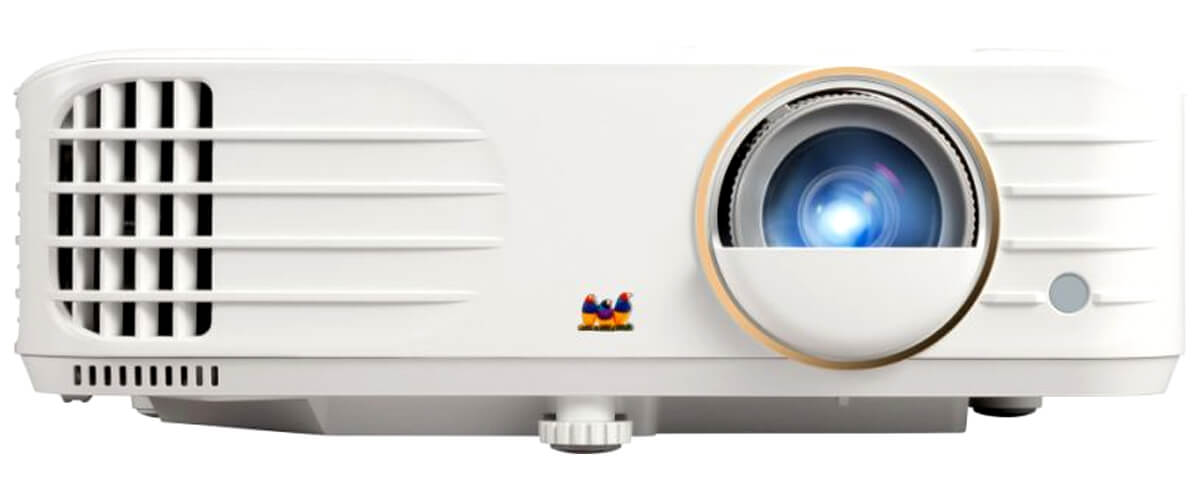
Sometimes your living room is too small for gathering all the sports fans to watch a match. Or you just want to bring your sports-watching experience outdoors. That’s when you will need ViewSonic PX748 4K. With 4,000 ANSI lumens it delivers, it will perfectly do for throwing a bright image on a bigger screen, even outside. In this regard, it even surpasses the Optoma UHD60.
PX748 is a 4K model with HDR/HLG support for pixel-free visuals and dynamic content reproduction. A 4.2 ms ultra-fast input and hyper-responsive 240Hz refresh rate, along with the microsecond-level response time, bring seamless viewing of fast-moving objects.
With auto settings, the image looks sharp with deep colors and extra dimension. But once you decide to adjust contrast and color manually, that’s where issues may occur. Dark scenes become nearly invisible. Therefore, be very careful when configuring the device settings yourself.
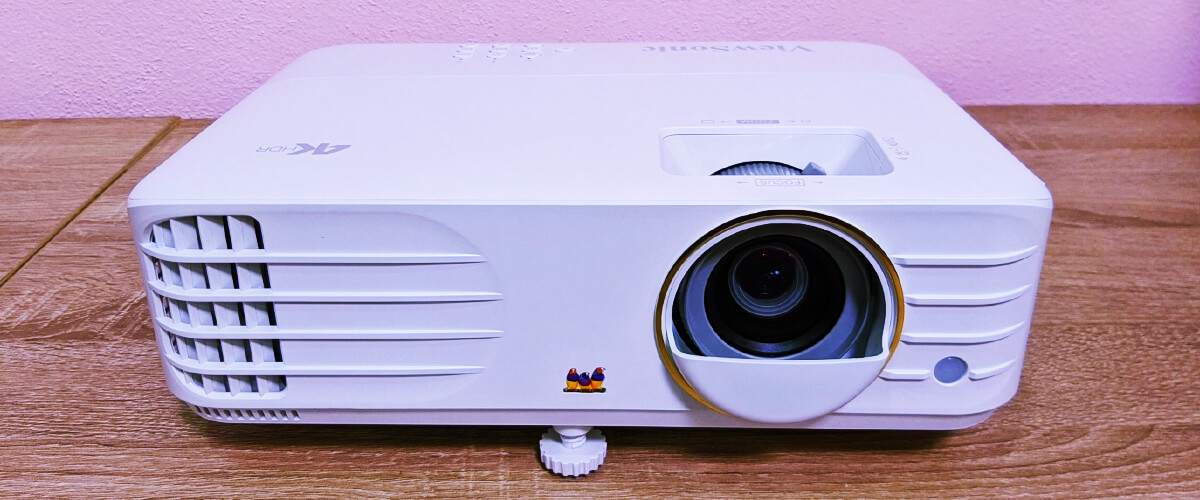
Unfortunately, there are no wireless connectivity options. Though you can use USB-C to connect your phone, laptop, or tablet for streaming sports shows directly to the screen.
For an image of 100 inches, you’ve got to have at least 8.2 feet between the screen and the device. It’s because of a 1.13-1.47 throw ratio. The Warping Tool makes it possible to project an image even on curved surfaces. You can achieve a perfectly shaped and centered image with a 1.3x optical zoom lens and horizontal/vertical keystone adjustment.
ViewSonic PX748 makes a perfect projector for outdoor sports watching thanks to its brightness parameters. Rapid refresh rate and 4K resolution let you see every detail, even when the players’ motions are fast.
Key specs
- Display technology: DLP.
- Resolution, px: 3840×2160.
- Brightness, ANSI lumens: 4000.
- Contrast: 12000:1.
- Throw distance, ft: 2.4-32.
- Image size, inch.: 30-300.
- Wi-Fi: no.
- Built-in speakers: yes.
Pros
- 4,000 lumens for excellent use even outdoors.
- Come with a USB-C port for simple connection to the phone or tablet.
- Reproduces fast-motion scenes greatly.
- Easy to set up and project an image even to a curved surface.
Cons
- No wireless connection opportunities.
- There may be a problem with manual adjustment.
BenQ TK800M – for sports bars
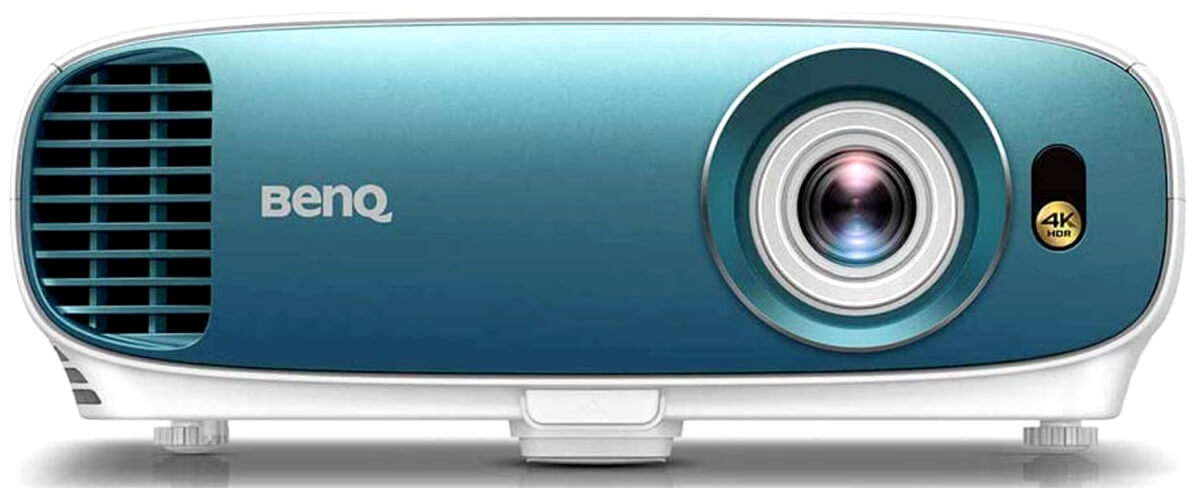
Bring vibrant 4K content on a bigger screen in your sports bar with the BenQ TK800M. Don’t you own one? Then this beauty will provide you with a great mood at home. With actual 4K 3840×2160 resolution, 8.3 million distinct pixels, and 3,000 lumens, this projector will let you showcase captivating content in any room with a moderate level of light.
The BenQ TK800M has been designed specifically for sports events. There is a Football mode for letting you enjoy every second of the game as the projector will naturally balance players’ skin tones, play fields, and tribune. I especially liked the image this projector delivers – it’s vivid, and the colors are precise. Even so, blacks are far from perfect – they are vague and lack definition.
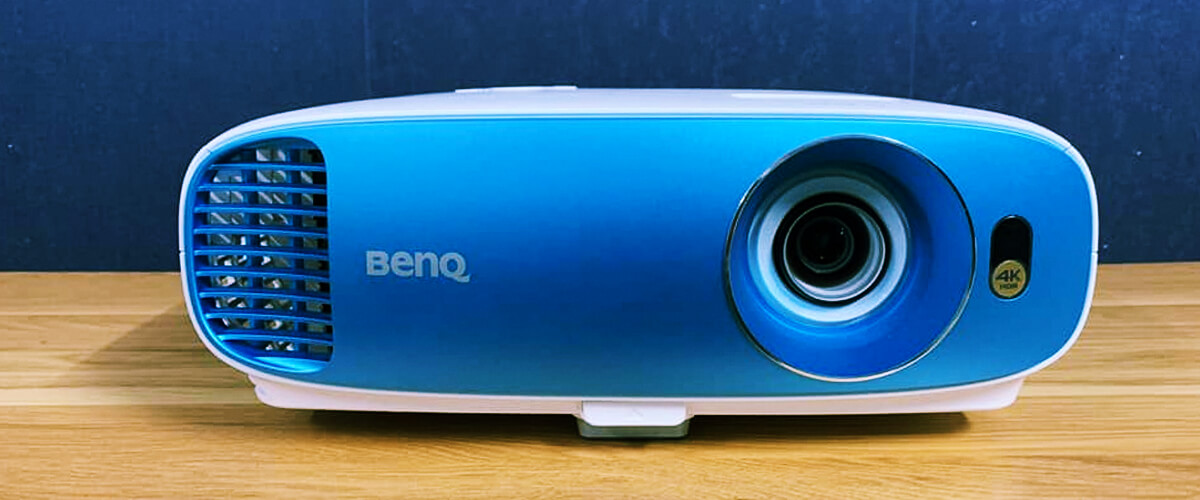
With the Sound mode, every announcer’s comment will be clearly heard, and the stadium’s cheering atmosphere will be brought right to your room. Though note that a built-in 5W speaker is not much capable of delivering an immersive surround sound, so you will need to connect the projector to external speakers. There is a 3.5 mm jack for that purpose. You will also find two HDMI, mini USB-B, USB-A, RS-232, and VGA ports. It’s a pity that there are no Android TV or wireless connectivity options.
It is a long-throw projector with a 1.50 – 1.65 throw ratio. For the 150-inch image, the projector should be 18 feet away from the screen. With 1x zoom and auto vertical keystone, you will easily find a place for BenQ TK800M.
With all said, BenQ TK800M is the best projector for sports bars. With a special Football mode, high brightness, and ultra HD content resolution, pub visitors will find the image sharp and detailed, even when the light is still on.
Key specs
- Display technology: DLP.
- Resolution, px: 3840×2160.
- Brightness, ANSI lumens: 3000.
- Contrast: 10000:1.
- Throw distance, ft: 10.9-18.
- Image size, inch.: 60-120.
- Wi-Fi: no.
- Built-in speakers: yes.
Pros
- Suitable for projecting sports shows even with dim lights on.
- Supports 4K 3840×2160 resolution.
- Modes optimized for streaming sports games.
Cons
- No Bluetooth or Wi-Fi for wireless connection.
- Blacks do not give the image the desired dimension.
Hisense PX1-PRO – short throw
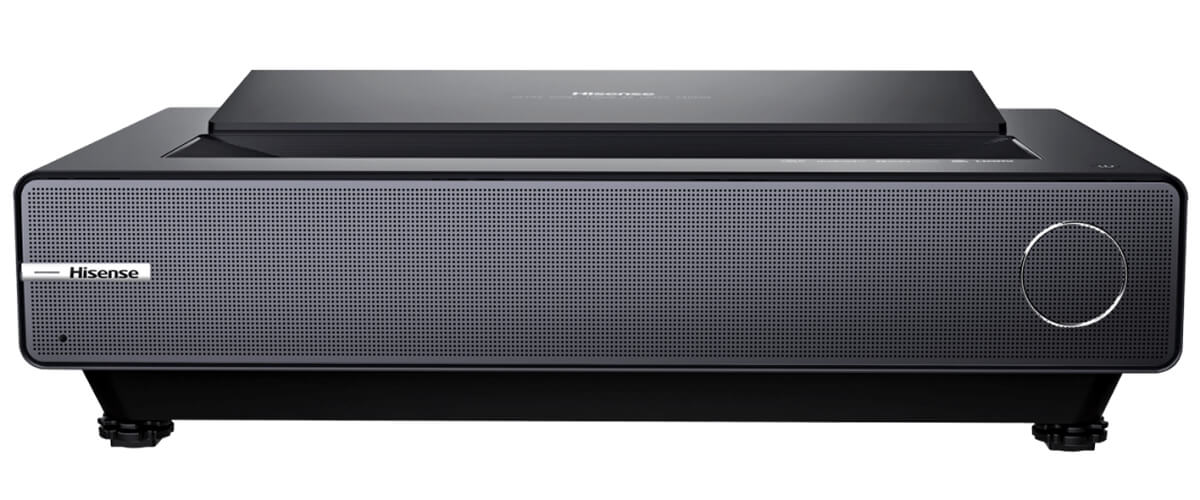
For environments with limited space, the laser short-throw Hisense PX1-PRO projector will be a good match. Just from a distance of 90 to 130 inches, it will produce a razor-sharp image of up to 130 inches. All without sacrificing the clarity and contrast of the projection.
As 4K Ultra HD and Dolby Vision support work together to optimize every high-dynamic scene, you will hardly complain about pixelization or the lack of detail. The High Dynamic Range is just what you need for a sports projector, as it throws content brimming with depth and color abundance. The same is true for the PX1-PRO’s microsecond-level processor response – it makes all fast-moving images buttery smooth and crystal clear. Though the peak brightness of 2200 lumens is a bit weak if you watch sports events in daylight. Nevertheless, it’s still enough to reproduce a large, bright image in the dark. It may withstand some minor ambient light but will definitely fail in the light room.
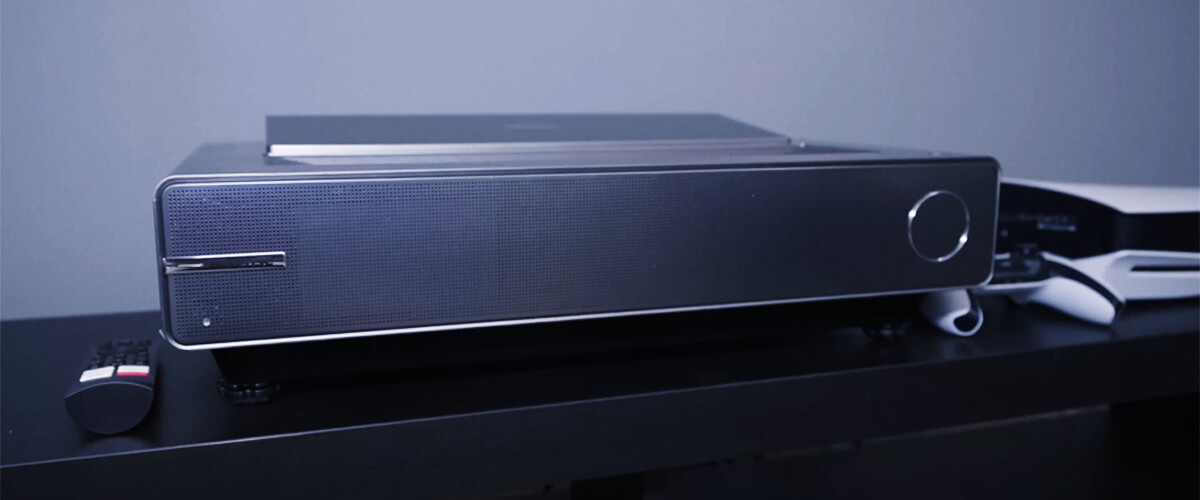
Hisense PX1-PRO boasts a smart TV feature, which is a significant advantage over BenQ TK800M if you plan to watch other content than sports events. However, Netflix is not included in the package. And that’s sad.
Sound is more than you expect from a projector. It has a 30W Dolby Atmos speaker, which cuts the need to invest in extra audio gear.
For a room with limited space, the Hisense PX1-PRO will make a great projector for watching sports. It can be placed just within 100 inches, and the screen will brim with voluminous colors.
Key specs
- Display technology: DLP.
- Resolution, px: 3840×2160.
- Brightness, ANSI lumens: 916.
- Contrast: 1000000:1.
- Throw distance, ft: 1-1.25.
- Image size, inch.: 90-130.
- Wi-Fi: yes.
- Built-in speakers: yes.
Pros
- Android TV with a variety of streaming apps.
- Dolby Atmos.
- Works great at reproducing fast-paced content without losing any detail.
- A short-throw device that will project a 100-image from around 100 inches.
Cons
- Netflix is not supported.
ViewSonic X10 4KE

Meet another projector that will turn your sports viewing experience into something even more exciting – ViewSonic X10 4KE. It is designed slightly differently than other projectors – its lightweight form and easy-to-carry handle make it a breeze to move between the rooms and even outdoors.
Similarly to the Hisense PX1-PRO, this is a short-throw projector. With a 0.8 throw ratio, you need only 1.6 – 11.5 feet to project an image of 30 – 200 inches. Manual vertical keystone and fixed zoom make it cumbersome to set up the image again and again after every projector relocation.
For the portable projector, ViewSonic X10 4KE is pretty capable. The DLP LED technology is capable of replicating 4K (3840×2160) content, delivering a sharp image without an annoying rainbow effect. However, I will note that HDR on this device is a complete disappointment. It’s too blown out, and all the colors are wrong. Recalibration didn’t save the day.
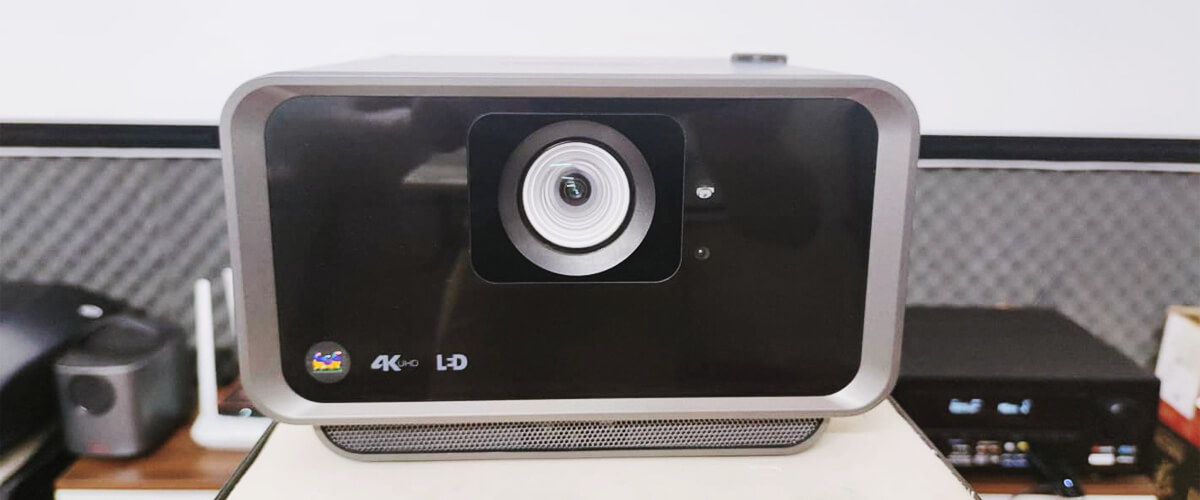
The brightness is higher than average compared to other portable projectors – it’s 2,400 lumens. This is more than enough to throw images with bright colors while withstanding insignificant ambient light. Though I would recommend using it in dark rooms for better performance.
The support of Amazon Alexa and Google Assistant compensates for the poor controller. Smart Wi-Fi connectivity that bridges you with favorite content providers like Netflix and YouTube is a pleasant bonus.
Despite the size and some minor flaws, ViewSonic X10 4KE’s capabilities impress. It is a good decision for a sports projector because it delivers a sharp image brimming with vivid colors and details, even in things where actions are super fast.
Key specs
- Display technology: DLP.
- Resolution, px: 3840×2160.
- Brightness, ANSI lumens: 1000.
- Contrast: N/A.
- Throw distance, ft: 1.6-11.5.
- Image size, inch.: 30-200.
- Wi-Fi: yes.
- Built-in speakers: yes.
Pros
- Compact and portable.
- Supports 4K content.
- Amazon Alexa and Google Assistant for voice control.
- Comes with your favorite streaming apps.
Cons
- There are questions about the HDR operation.
- The controller is hard to use.
FAQ
How many lumens do I need for an outdoor projector?
Can a projector be used in daylight?
Can I plug my phone into my projector?
Are outdoor projectors worth it?
You also can consider other decent projectors:




